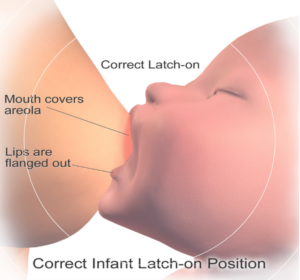Welcome to this week’s blog post! Breastfeeding can be a beautiful and bonding experience, but it also comes with its challenges. One of the most common concerns for new mothers is whether their baby is latching well and drinking enough from the breast. In this post, we’ll explore the signs of a good latch and how to ensure your baby is getting enough milk. Let’s dive in! Be sure to download one of my freebies, if you haven’t already done so! “Why is My Newborn So Fussy?”“Does My Baby Have a Tongue Tie?”
Understanding a Good Latch

A good latch is crucial for effective breastfeeding. When your baby latches well, they can efficiently transfer milk, which helps them grow and thrive. Here are some signs that indicate your baby is latching well:
1. Comfortable Positioning: Both you and your baby should be comfortable. Hold your baby close with their body facing yours. Their head, neck, and spine should be aligned.
2. Wide Open Mouth: Your baby’s mouth should be wide open, covering more of the areola (the dark area around the nipple) rather than just the nipple itself.
3. Chin and Nose Touching the Breast: Your baby’s chin should be pressed into your breast, and their nose should be touching it lightly.
4. No Pain: While some initial discomfort is normal, breastfeeding should not be painful. If you experience sharp pain, it may indicate a poor latch.
5. Rhythmic Sucking and Swallowing: You should hear or see your baby swallowing after every one or two sucks. This indicates they are getting milk.
Ensuring Your Baby is Getting Enough Milk
Knowing if your baby is drinking enough from the breast can be challenging, especially for new mothers. Here are some indicators to watch for:
1. Weight Gain: Regular weight gain is one of the best signs that your baby is getting enough milk. Newborns typically lose some weight in the first few days, but they should start gaining consistently starting around day 4-5. Goal to regain birth weight by around 2 weeks of age.
2. Wet and Dirty Diapers: Your baby should have at least six wet diapers and three to four dirty diapers per day after the first week. This is a good sign they are getting enough milk.
3. Content After Feeding: A well-fed baby will usually appear content and satisfied after a feeding session. If your baby seems fussy or hungry shortly after feeding, they may not be getting enough milk.
4. Breast Softening: Your breasts should feel softer and less full after feeding, indicating that your baby has effectively removed the milk.
5. Active Feeding Sessions: During a feeding, your baby should be actively sucking and swallowing for about 10-20 minutes per breast. It’s also common for some babies to feed for a shorter period of time and some babies for a longer period of time. This is just an average.
Tips for Improving Latch and Milk Intake
If you’re concerned about your baby’s latch or milk intake, here are some tips to help:
1. Seek Professional Help: Don’t hesitate to reach out to a lactation consultant. They can provide personalized advice and support to help you and your baby with breastfeeding.
2. Try Different Positions: Experiment with different breastfeeding positions to find the one that works best for you and your baby. The cradle hold, cross-cradle hold, and football hold are popular options. I show a few of these in one of my IG reels.
3. Ensure Proper Alignment: Make sure your baby’s head, neck, and spine are aligned during feeding. This alignment helps them latch more effectively. Check out my IG reel for a visual.
4. Use Breast Compression: Gently compress your breast during feeding to help increase milk flow. This can encourage your baby to suck more effectively.
5. Stay Hydrated and Nourished: Drink plenty of water and eat a balanced diet to support your milk supply. Your body needs extra calories and nutrients to produce enough milk.
Nursing Insights
Breastfeeding can be a rewarding experience, but it often requires patience and practice. By understanding the signs of a good latch and knowing how to ensure your baby is getting enough milk, you can feel more confident in your breastfeeding journey. Remember, every mother and baby is unique, so what works for one may not work for another. Trust your instincts and seek support when needed.
If you’re struggling with breastfeeding or have concerns about your baby’s latch or milk intake, don’t hesitate to reach out for help. Contact me here, and I’ll provide the guidance and support you need to ensure your baby is thriving.
References
La Leche League International. (2024, February 21). Breastfeeding Information – A to Z – La Leche League International. https://www.llli.org/breastfeeding-info/
Nightingale, C. (2024, May 1). A Supportive Guide to Weaning from Breastfeeding. The Mama Coach – Crystal Nightingale. https://crystal-nightingale.themamacoach.com/weaning-from-breastfeeding/



